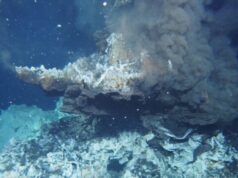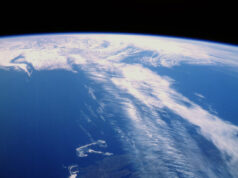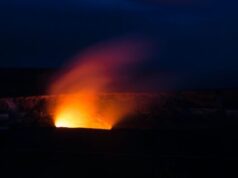New research suggests that the Hiawatha impact crater beneath ice could have been formed during the Pleistocene geological epoch. The 31-kilometer-wide crater first came to the world’s attention in 2018 when a team led by the University of Copenhagen published research revealing its existence.
Hidden beneath a kilometer of ice in northwestern Greenland, an impact crater that could swallow a city the size of London, Ont. is the subject of much debate about its origins and age.
Now, Western planetary scientist Elizabeth Silber has published new research suggesting the crater could be young—as craters go—having formed during the Pleistocene geological epoch, between 11,700 and 2.6 million years ago.
The impact of the asteroid thought to have created the Hiawatha crater would have produced so much heat that the ice sheet would have released a massive volume of meltwater “in pretty much an instant,” Silber said. She estimates it would have produced enough water to fill Lake Tahoe, which straddles California and Nevada.
“It is a rarity to find a new impact crater on Earth, let alone one of this size,” said Silber, an adjunct professor with Western’s department of earth sciences.
Find your dream job in the space industry. Check our Space Job Board »
“While some 190 impact structures have been cataloged thus far, this putative crater is interesting because it looks geologically young and well preserved and, if confirmed, it will be among the largest ever found on Earth,” she said. “Because it is hiding beneath the ice sheet it begs the question (of) when it might have formed, and whether the ice existed at the time.”
The 31-kilometer-wide crater first came to the world’s attention in 2018 when a team led by the University of Copenhagen published research revealing its existence. The discovery sparked a lively debate about whether the two-kilometer-wide asteroid believed to have made it hit before or after the Greenland Ice Sheet formed about 2.6 million years ago.

“Because it is very well preserved, it points to a possibly very young age, as young as the onset of the Younger Dryas period (between 11,500 and 14,500 years ago),” said Silber. “Or alternatively, if old, it tells us about the erosional processes that might have taken place in that area.”
Silber studies how impact craters form on various planetary bodies, including Jupiter’s moon Europa, Saturn’s moon Titan, our moon, and Earth. She also studies the physics of meteors, or shooting stars.
So, she was well placed to put together a team, including some of the researchers who made the initial discovery, to shed light on the crater’s formation and age.
The team used hydrocode modeling, a numerical tool that describes the physics behind the shockwaves that cause impact craters to form. The modeling takes into account the projectile’s composition, target and impact speed, as well as surface temperature and other factors.
“Modeling formation of impacts into terrestrial ice sheets has never been done before, and it serves to shed light on why the crater is unusual in terms of morphology and why the rocky ejecta is absent from drill cores,” Silber said.
Shockwave physics assume that an impact this big should form a peak-ring basin with a pronounced crater rim if an asteroid slams directly into bedrock. But the Hiawatha crater has a central uplift and muted morphology, which means that the crater rim is less pronounced. The formation of the central uplift makes sense, however, if an asteroid hit at a time when the land was covered with ice at the height of the sheet’s thickness (likely 1.5 to 2 kilometers).
“The modeling shows that thick overlying ice in fact serves to muffle the formation of a peak-ring basin,” said Silber. “Furthermore, the nearby drill cores don’t show any rocky ejecta from the impact, and our study shows that ice sheets inhibit ejection of rocky material during the impact.”
While it wasn’t the focus of her paper, Silber calculated some of the likely after-effects of a large asteroid slamming into the ice sheet. She came up with a dramatic picture: supersonic winds of 400 kilometers an hour ripping down trees within a 200-kilometer radius and stripping them of branches and leaves. Anyone within a 500-kilometer radius would have seen a white-hot fireball that appeared four times larger than the sun, she said.
“From a scientific standpoint, we want to know how something might have occurred and how it might have affected the region. After all, the Chixculub impact, which was significantly larger than the Hiawatha impact, was responsible for wiping out the dinosaurs some 65 million years ago.”











